The National School
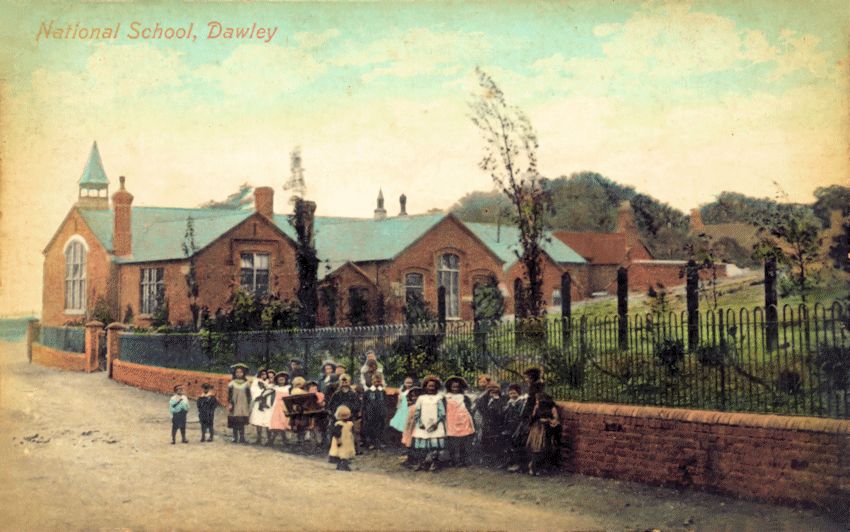
The National School, Doseley Road, Dawley, (c) 1910
Dawley (mixed), built in 1841, & enlarged in 1893, 1899 & 1904, for 370 children ; average attendance, 300
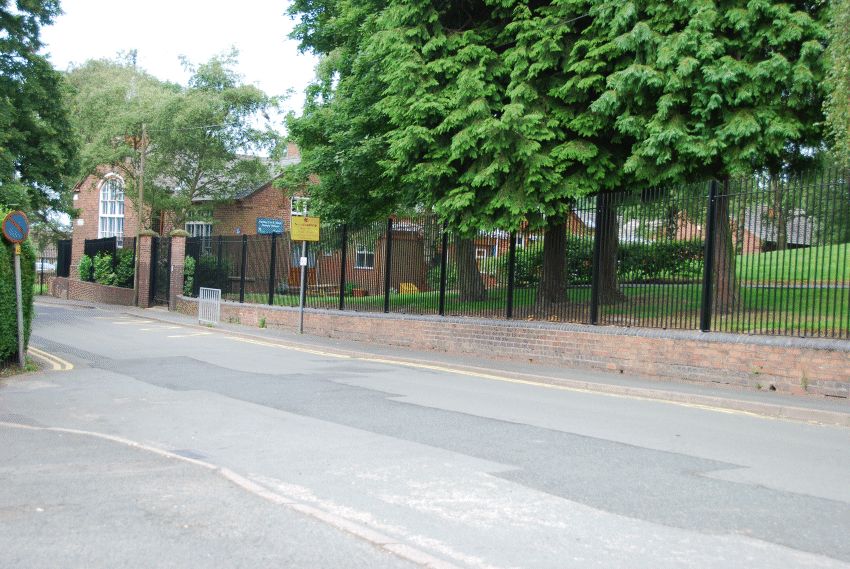
The trees have grown and so has the gate posts!
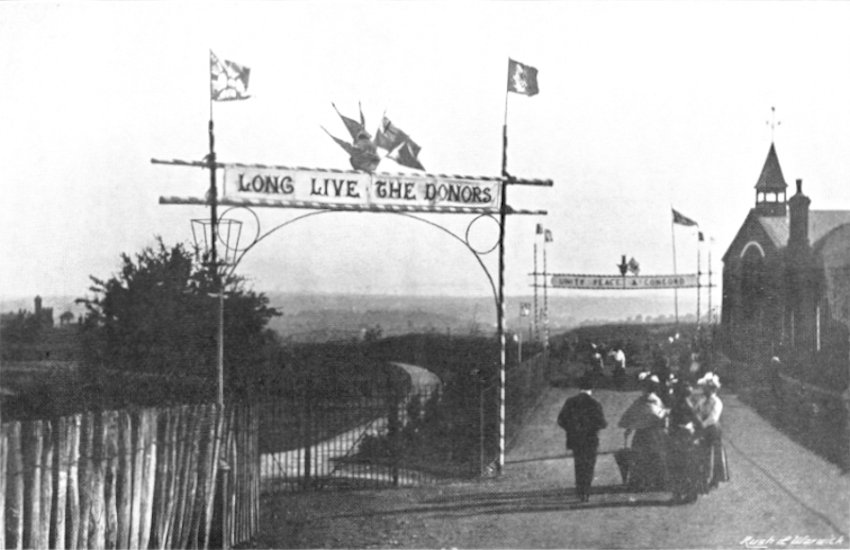
Coronation 1902
Photo courtesy of Dawley History Group.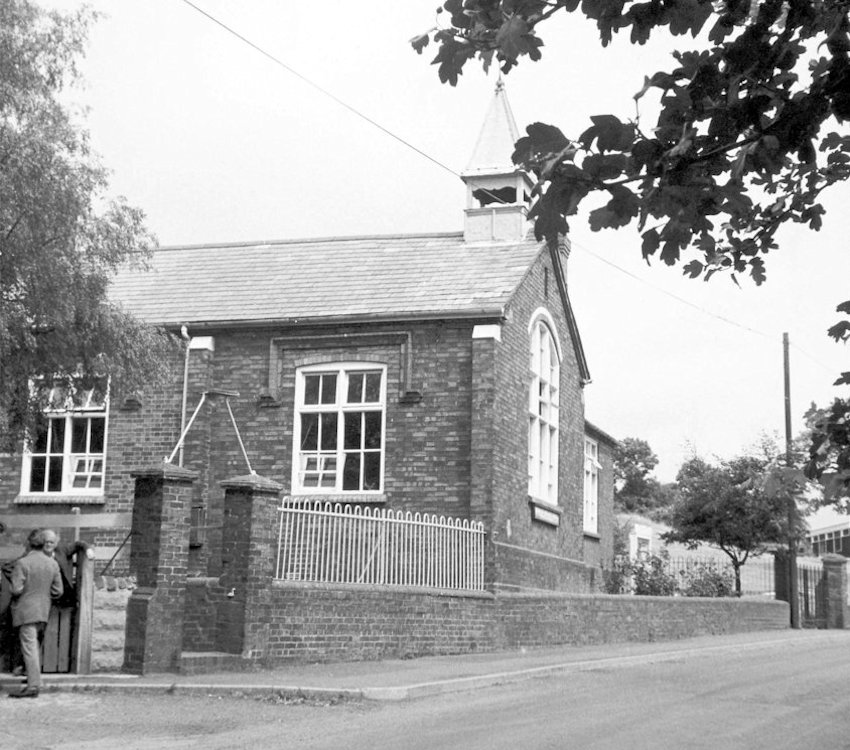 Photo courtesy of Dawley History Group.
Photo courtesy of Dawley History Group.
Dawley C of E School Sports Day in Dawley Park
Photo courtesy of Dawley History Group.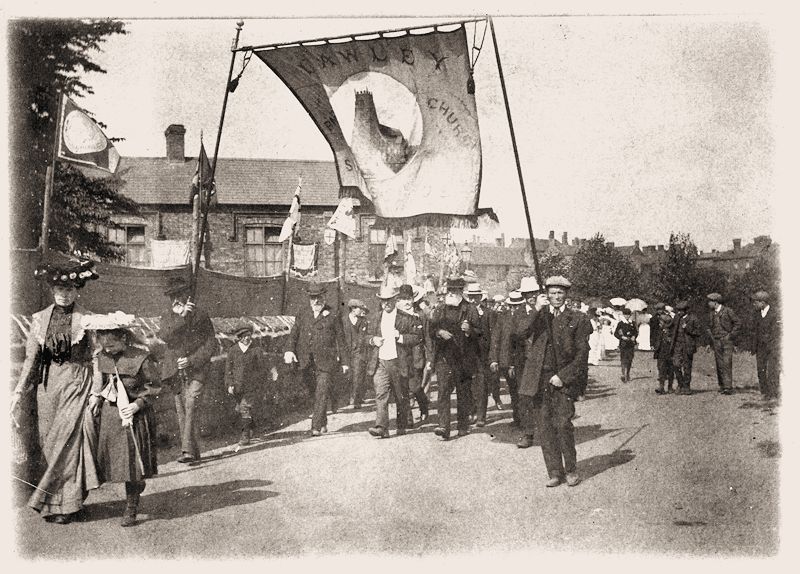
Dawley Church procession passing The National School Doseley road on it’s way to the vicarage, The building on the left is The National School with the school bell tower being hid behind the banner, Dawley Park is on the right, and the buildings in the back ground are in the High Street, Burton Street and George Street area of Dawley.
A SHORT HISTORY OF DAWLEY CE SCHOOL
By Sue Wolfe.

Introduction:
My first encounter with Dawley C of E School was in 1980 when our family moved to Shropshire and we
settled in Dawley. After my two daughters started school at ‘The National’ I soon became involved in
the school. Mr John Rice, the headteacher asked if I could do some supply teaching and that was the
beginning of twenty-five happy years teaching at Dawley C of E until I retired in 2005.
I had often wanted to compile a history of Dawley C of E School (The National) and had over the years collected a growing number of photographs and information about the school. After I attended a local history course as part of the Dawley Heritage Project in the autumn term of 2009 I began to research, collate and record the information about the school. I would like to thank Shropshire Archives, Malcolm Peel, Suzette Collier and Joan Bellamy for their contributions.
This short history of the Dawley C of E School is not complete. I intend to collect the memories of those pupils and staff that have been connected with the school up to the present day. If you have memories, photographs or information relating to the school please contact Sue Wolfe. (01952 501218) Sue Wolfe
Early Education in Dawley:
In the 17th and 18th centuries there were few schools in Dawley. Richard Wilding, the curate for Dawley in 1605,
and William Banks, the rector of Stirchley from 1715 to 1758, probably held schools in the Dawley area. Richard
Poyner was recorded as the schoolmaster there from 1718 to 1722.
By 1772 I. H. Browne, the owner of Malinslee was paying for the schooling of 15 children, most probably in the
Sunday school that he and his tenants, the Botfields supported in 1779. By 1833 there were 8 Sunday Schools. Two
were run by the established church and supported by subscription and six were provided by the non conformists.
Public day schools were founded from 1832 and in 1875 a school board for the parish was formed.
The National School was founded on February 23rd 1841 with the gift of land by one Richard Slaney for the purpose
of establishing a school for local children. It was built on land next to the Parsonage but overshadowed by coal spoil tips.
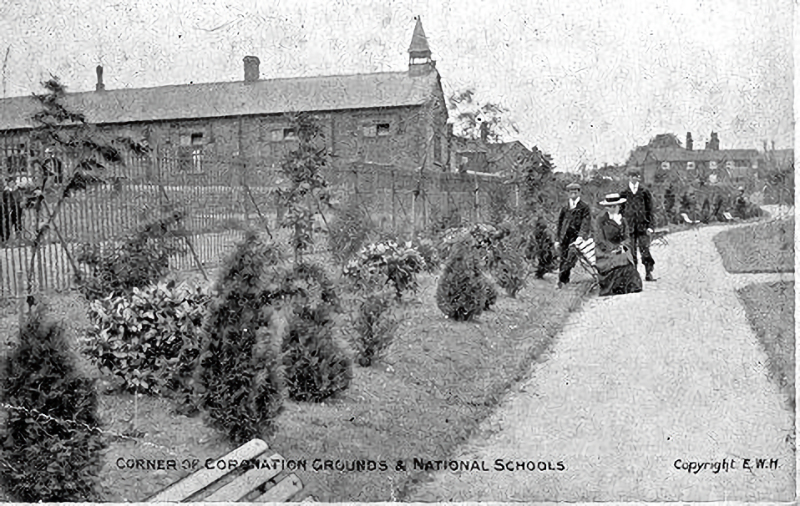
The National School (Dawley Church of England)
From its foundation in 1841 Dawley C of E School (The National) has been extended and remodelled to accommodate a growing number of children over the years
THE NATIONAL SCHOOL:
Dawley Church of England School
23rd February 1841
Robert Aglionby Slaney gave the gift of site near to the parsonage house to the Rev John Wood curate of the parish
Church of Dawley. The cost was £30. In the letter from the surveyor it states that it was for ‘the education of poor
children to be united to the National Society for the education of the poor in the principles of the established church’
15th March 1844
The National Society gave a grant of £60 to convert the barn into a school. The letter from the National Society
states-‘I am happy to inform you that the committee of the National Society are willing to guarantee £60 towards
the completion of the whole undertaking upon certain conditions. They will expect the site to be conveyed to
Trustees for the purposes of a school’
They hoped that the price of the barn on the site would be abated as it was too high. The cost was £250 to build
the school.
December 1898
A license for the performance of ‘divine service’ in the National School room in Dawley Green is granted where
there are over 2,000 persons resident in the immediate vicinity of the schoolroom with no church accommodation.
9th September 1898
One acre of land at the rear of the school was purchased for £20.
Between 1892 and 1899 the building was enlarged and an infant department was added
1905
New classroom was completed and the outside toilet blocks were enlarged. Cost £428
1952
The school became an Aided school.
1956
Children left at 11 years of age. (Dawley Modern School opened)
1966-1973
Because of lack of space, demountable classrooms were erected and indoor toilets built.
1975
Nursery class was started in demountable classroom.
1985-1986
Major remodelling of building takes place. The school house was demolished. Two
new classrooms, toilets, staff room and Head teacher’s office are built. Three other
classrooms were enlarged providing them with art areas. Cost £250,000.
1991
Nursery classroom was built.
1995
New school was built. The ‘old hall’ was converted into a library area and classroom.
1990’s
Key Stage 1 classroom was built (funded by government scheme to ensure there was a limit of 30 children in Key Stage 1 classes).
Extracts from the Log Books
The head teacher was required to record in the log book on a regular basis. The earliest log book for Dawley National
School in the Shropshire Archives is the one that covers the years 1893 to 1938 for the Infant Department. As I read
through them, the people involved in the school came to ‘life’ and the education of the children developed and changed
with each era. In the 1890s lessons were very different from those of today. The three Rs, (reading, writing and
arithmetic) were important as were Religious Instruction and ‘Object Lessons’
The extracts are divided into the following areas – the school day and lessons, the wider curriculum, the building,
school closures and inspectors’ reports. They range from 1893 to 1964.
The School Day.
May 29th 1893
The times of the school day are 9am to 12noon and 1.30 to 3.30 pm. The average school attendance is 73.
Lessons:
In 1893 the girls were taught needlework and the boys were taught drawing three times a week.
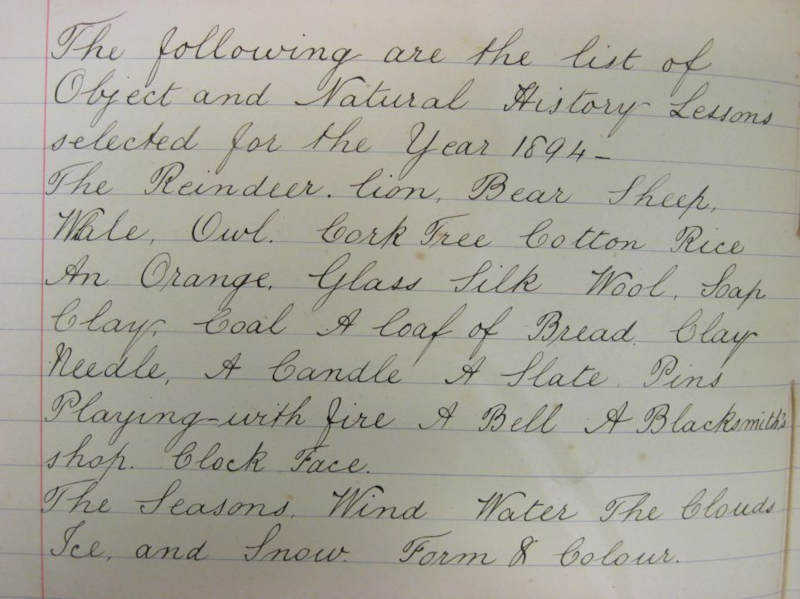
At the beginning of each school year in the 1890’s a list of object lessons were written down. The object lessons for 1893 were - the elephant, the camel, cow, dog, ostrich and birds, papermaking, leather, tea, coffee, sugar, iron, coins, salt, the clock face, the railway station, rain, sun, the fire, water, the air, form, colour, the earth.
Songs were also taught on a regular basis. These included: Buzz, Fuzz was a jolly fly’; ‘Who is full of fun and glee’; ‘I had a little dolly’; ‘Puss so shy shuts his eye’ ‘Three mice went into a hole to spin’
The lessons in the Kindergarten in 1894 were: Recitations throughout the school; Musical Drill; Stick laying; Mat Weaving; Building; Ravelling and Bead Threading
The Wider Curriculum
11th May 1949
Miss Heron, Horticultural Adviser called today to discuss plan for the new school garden
(the field adjoining the school) which the Vicar has consented to let us use as a garden.
14th December 1949
Social Hour in the hall at 3.45pm. A splendid programme was given by our boys and girls.
Thanks to the school were expressed by Mrs H. E. Phillips. Light refreshments were provided
for the parents at the close.
1st May 1951
Miss Lewis took 12 children to dance at the West Mids Show.
28th June 1952
Twenty boys and girls attended Junior Musical Festival at Wellington. They played recorders,
sang and danced. All the staff were present.
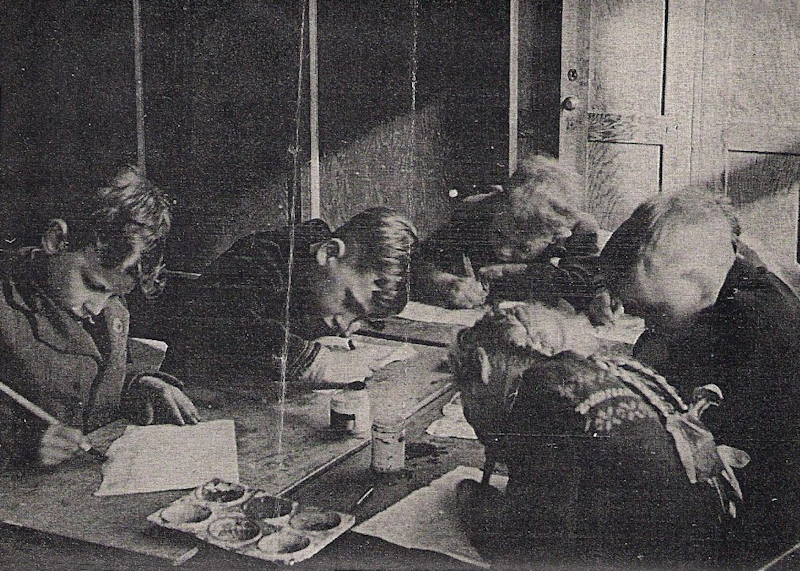
7th June 1949
Miss Barnet took 14 boys and 13 girls to public baths at Wellington via the Midland Bus.
16th June 1949
The boys played Langley boys at cricket, match abandoned because of rain.
22nd July 1949
School nurse visited and examined heads of those children previously infected.
29th September 1949
Boys played Ketley at football and won 6-0
7th October 1953
Headmaster took Class 1 to Brandlee Clay mine. Miss Lewis took Class 3 for a nature walk.
21st May 1958
School Choir and Recorder Band sang and played at the Wrekin Music Festival accompanied by Miss Lewis.
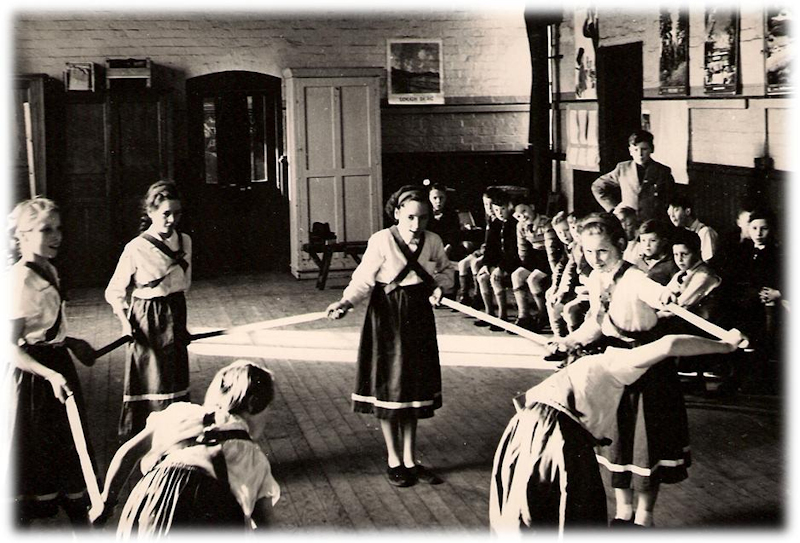
The School Building
Over the years the school building has been changed and enlarged to cater for numbers of children and the different styles of teaching. In the original part of the building it is still possible to see where the stoves once kept the rooms warm and the wooden cladding is still visible in three of the classrooms. In the classroom at the end of the building with the large window, there was a rope by which the school bell was rung.
1898 –Inspector’s Report
Want of a classroom is much felt here the room being much overcrowded.
The school has again increased and I am glad to hear that the managers are contemplating the
addition of a room for the babes.
April 22nd 1904<
The baby class desks are in great request. It is impossible to use books for writing unless more
desks are obtained.
1907t
The arrangements for teaching in the classroom have been greatly improved by the removal of the
gallery. The removal of the steep gallery in the main room would be equally beneficial.
30th November 1908
The room this morning is very cold. The fires had only been lighted a very short time when school commenced.
January 26th 1917 Weather very severe and attendance is correspondingly poor. The room is very cold and as there is only one fireplace the two classes have been occupying the top end of the room. The lower end of room is never more than 43 degrees.
14th January 1936
The stove smoked.
National Events
7th July 1893
A day’s holiday was given on Thursday July 6th for the Royal Wedding.
21st June 1897
School closed today (Monday) for the remainder of the week to commemorate the Queen’s Jubilee. Children were
presented with a medal and had tea given to them in the Market Hall. In consequence there was a large
attendance at school on Monday. Average attendance for week 100.5.
2nd June 1902
This morning the declaration of Peace was proclaimed. Rev. Fawkes gave thanksgiving for Peace and the National
Anthem was sung.
25th May 1908
At 11.30am children assembled in the yard, saluted the flag and sang an Empire song. Sang the National
Anthem and after cheers had been given for the King and Queen the children were dismissed.
5th September 1939
Should have re-opened school, but as war was declared with Germany on Sunday 3rd and the
school had been used for Evacuees- women and children under 5 years – only 24 children
attended. These were sent home until Mon 11th. Teachers attended school each day from
Friday Sept 1st to assist evacuees who actually only came here on Sat Sept 2nd.
1st July 1953
All children attended Cosy Cinema to see ‘A Queen is Crowned’ by kind invitation of the management.
Local events:
30th September 1895 School closed on Thursday afternoon so that the teachers could help in the church decorations for the Harvest Festival.
25th October 1895
Closed as it was the Jubilee of The Parish Church.
Weather:
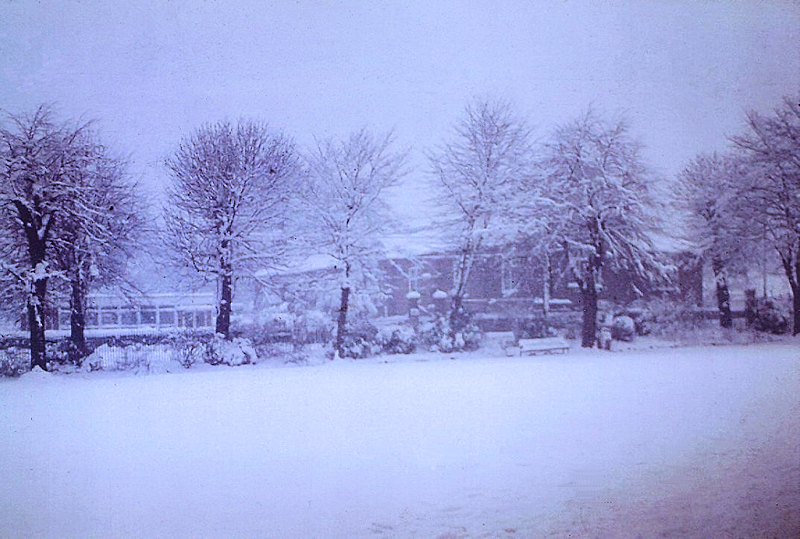
January 1894
The weather – rain and snow has affected attendance. School closed due to heavy snow.
October 12th 1895
Closed school this afternoon on account of a very heavy storm about the time of children coming
to school. The teachers and children were so wet that it was thought unwise to remain in the wet clothes.
Illness:
There are a number of entries relating to illness. The children suffered from measles, whooping cough, influenza, mumps and one child died from diphtheria.
Dec 8th 1895
Closed for 3 weeks on account of measles.
Dec 3rd 1897
Numbers fallen off dreadfully this week owing to the prevalence of measles.
Dec 10th 1897
School closed today for 3 weeks by order of the Medical Officer.
Jan 28th 1902
Epidemic of measles.
March 9th 1917
School closed on account of measles.
June 21st 1917
Epidemic of mumps.
Oct 8th 1917
Epidemic of influenza.
Absenteeism:
There were also references to children’s absenteeism. The children were often absent from school as they were away hop picking in the autumn.
Sept 27th 1901
Children away hop picking.
Sept 2nd 1940
Evacuees admitted. Some hop pickers away at Tenbury.
7th Sept 1952 Six children went hop picking.
Inspectors Reports:
At the end of each year there was an inspection of Religious Instruction. There were also regular inspection reports from HMI (Her/His Majesty’s Inspectors). The report was then written into the log book.
1894 -Report of Religious Instruction
The answering and repetition may be classed as good but I should like
to see a little more energy and life in the school.
1898- Report of Religious Instruction
The school has again increased and I am glad to hear that the managers are
contemplating the addition of a room for the babies.
Nov 12th 1901- Inspection Report
The school is being conducted in the right spirit. Quiet discipline secures
order and attention on the part of the infants and the teaching is sound and
suited to the capabilities of the children.
May 2nd 1902
The arithmetic on slates was very well done.
1904 -Summary of HMI Report
Infant School – The teaching is fairly intelligent and the results are creditable.
The work of the teachers is however greatly handicapped by the overcrowded state
of the premises and by the want of sufficient number of suitable desks. A cupboard
is also needed for the storage of the school materials.
23rd March 1948 -Diocesan Report received from Rev Dr Lawson
The Diocesan syllabus is being faithfully used and an adequate programme of
work was carefully and correctly recited. There was a good knowledge of the
Catechism and of the Bible lessons. In answering oral questions the children
showed interest and were quite clear.
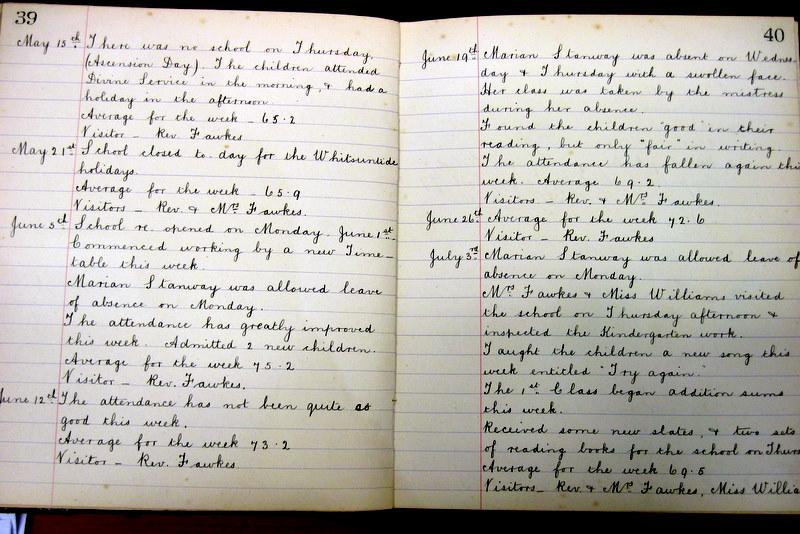
12th July 1950 – HMI Report The school provides education for children whose ages range from 5 to 13 years at which age they are transferred to Pool Hill County School. The building consists of 4 classrooms and a hall. There are 114 children on roll. The playground in the front is very small (198 sq ft) while that at the back can hardly be called a playground at all and is in fact a pit-mound.
Memories:
Malcolm Peel:
I started at the National at the beginning of the autumn term in 1948. I cannot remember this first day, or much of the later years, but I do remember the teacher was Miss Wase and that we were in class 4. For the first year, we used the smaller room nearest the road, but because of the number of pupils, we swapped with class 3 and moved into the larger room at that end of the school. At that time, the school consisted of four class rooms; the hall, a kitchen and two cloak rooms. The toilets were outside, across the play-ground. Heating in each class room was by way of a large coal fire at one end which was only lit on very cold days. The play ground also consisted of a pit mound, referred to as the “clay mound”, and on which, in dry weather, we boys pretended to be working in an open-cast coalmine. The idea was to dig a hole and find small pieces of coal, which we loaded into our Dinky Toy Lorries. In wet weather, this mound was totally out of bounds and woe betides anybody that went on it. The trail of mud and clay was a dead give-away. Miss Elsie Wase was one of a family of teachers, all unmarried, who lived in King Street. She had taught my mother at the National.
Lessons were very basic, and for writing practice we copied what Miss Wase had written on the board. This was always the same and only varied depending on the day of the week and the weather, i.e. “Today is Monday and it is raining outside”. She taught us the alphabet by holding up large cards with the letters and an illustration on and we repeated out loud the letter phonetically.
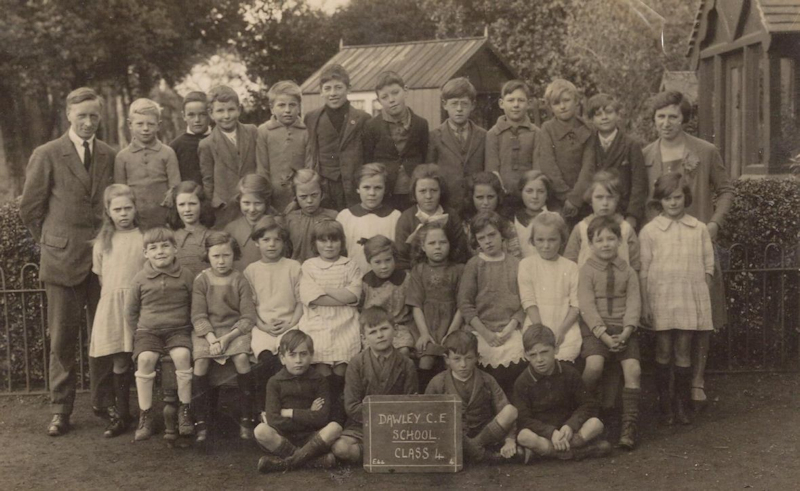
One of the toys we played with was the “Hammer & Nails Set”. Every boy wanted to play with these but there were only two sets for the class. It consisted of a pad of thick felt on which we could nail pre-drilled wooden shapes. During the mid-day dinner break, we were allowed to play in Dawley Park. Where the bowling green is now, there used to be a large sand pit, and for the boys, the favourite game was to push a house brick through the sand and pretend that it was a lorry and the trail left behind was the road.
To get to school, I walked with my mother from the Potteries, along Station Road to Dawley. She worked in the “fields”, picking potatoes, and we would call in Morgan’s Newsagents shop, which was situated at the top of Doseley Road, and I would be given two ounces of sweets and then made my own way down to the school.
I think Miss Barnet was the teacher in class 3, but by the time I moved up, Miss Lewis had taken over. Nellie Lewis was one of those people you never forget. She was a very dedicated teacher, and was involved in numerous activities, both in and outside the school. She formed various dancing teams, for which she played the piano, and they would perform at numerous local functions. I was a member of the “Morris” dancing team in which we used sticks, handkerchiefs and wooden swords. If you failed to pay attention during her class, she had a bad habit of tapping you on the head with her metal whistle.
I moved up into class 2 in 1952 where George Evans, the well known Wellington author, was the teacher and who was later replaced by Warwick Tart. Both teachers were liked and respected. Mr. Tart, who I still keep in touch with, was responsible for sport. This was basically football in winter and cricket in summer, with a little bit of athletics close to the time of the annual sports day. Mr Tart instigated a “pen pal” club, where we wrote to pupils of the same age in a class at Pool Hill School, and they wrote back. It wasn’t until a few years later that I found out that he was writing to their class teacher; a Miss Weatherbee, who he later married. Mr. Tart also tried to instil in us pupils, an appreciation of classical music; but he failed.
It was at about this time that we sat the exam called “eleven plus”. Well I think it was, because, nobody told us about it and I had not done any preparation. It was not until a few years later, when people were discussing it, that it occurred to me that this exam that we had taken in the middle of a term, was this important exam. The results from this examination determined your future education; some pupils gaining entry to Coalbrookdale High School and some to the Walker Technical Collage at Oakengates. I continued on at the National and moved up to class 1 in 1954.
The teacher in this class, and the head teacher for the school, was Mr. Eric Latham. He was some-what feared by us pupils, but in later years, he was much respected. He lived in Wellington and was the only person, out of teachers or parents, with a car. this I remember was a “Hillman”, and he parked it at the side of the school, in Doseley Road. He was responsible for forming the school choir, and also the recorder band. He made the large bass recorders, during class time, out of bamboo and a cork for the mouth piece.
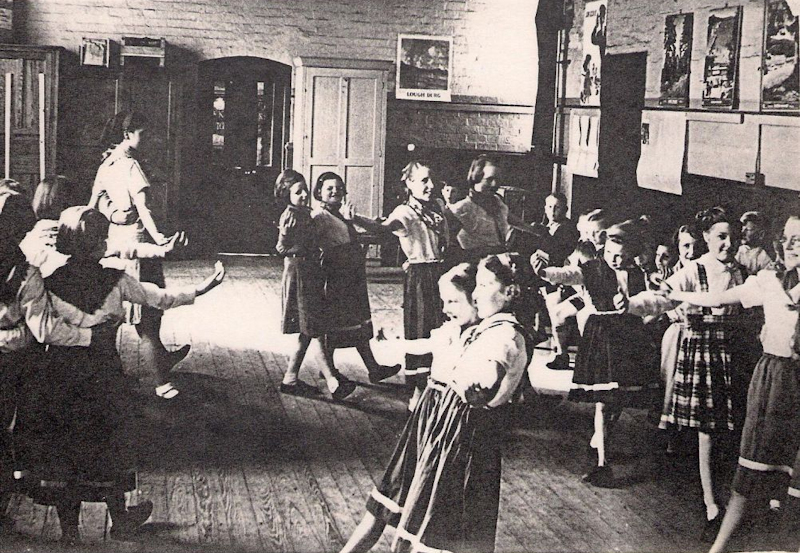
I was a member of the choir and the dancing troop but now, I can neither sing nor dance.
Mr Latham occasionally turned up at school with his arm in a sling. We never found out what his problem was, but the material for the sling was made from the same material as the class room curtains. This was black and was possibly the curtains used in the war time black-out. If he was conducting the choir, he would remove his arm from the sling and wave it about and the sling would still be around his neck.
Meals were served from the kitchen by two ladies; Mrs. Dolly Bird and Mrs. Beatie Stephen. These dinners were cooked at a canteen in Station Road, near to where the car hire company is now, and delivered to the school by Mr. Gilbert Corbett. A few of the older boys took it upon themselves, at the end of the meal, to clear the plates away and to remove the trestle tables and benches. For this we were rewarded, at the next meal time, with extra pudding. It was my job to deliver the waste food, which was collected in a bucket, to Mrs Stephen’s house, where it was later passed on to a Mr. Jack Buttery to feed his pigs. (Recycling is not new).
Gilbert Corbett was also the projectionist at the Cosy Cinema.
Another pastime indulged in by the boys was to make paper aeroplanes; we called them “gliders”. These were made from two pages ripped from our school text book, which were never missed by the teachers. The challenge was to fly your glider over the school building, but they usually ended up in the guttering or on the roof. Ted Shepherd was the only one I can recall doing it.
Under Mr. Latham’s direction, the boys also spent time digging the school garden, and I with another boy named Charles Athersmith, had the job of cutting the lawn. Charles eventually had the job of Head Park Keeper in Dawley Park. To think that we spent a lot of time and effort in that garden and later generations went and built an extension on it. One of the things Mr. Latham tried to do was to get us Dawley folk to talk proper. I think now that this was wrong, the broad Dawley dialect is unique and should be maintained. To quote George Evans: - “They conner talk proper and them as con, dunner”.
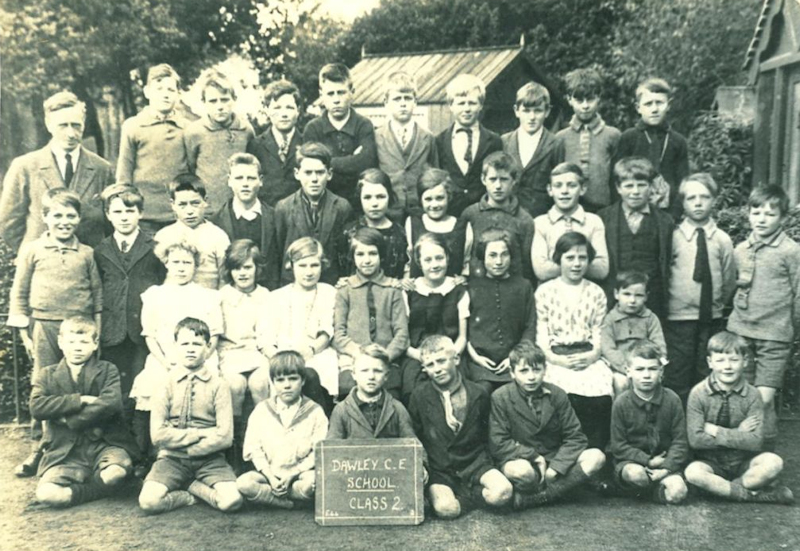
In my last year at the school, I was appointed Head Boy; why? I don’t know. After eight years, I left the National School in 1956, and was amongst the first intake of pupils at the newly built Dawley Secondary Modern; now called the Phoenix.
Looking back; I think we had a good basic education at Dawley Church of England School, and today most of the pupils still hold a great deal of respect for the school and teachers. We didn’t have a good football team and never beat Langley, but we enjoyed ourselves and I had no reservations in sending my two children to this school. In fact, my granddaughter was the fifth generation of my family to attended Dawley National School.
Memories:
1940s and 1950s
Suzette Collier
I started school at the age of four in 1947 in the Eater term I think. Miss Elsie Wace was my teacher. She was the ideal teacher for almost any child to start with I would say. She was a lovely person and we all loved her. She was a petite lady with a beautiful speaking voice, very smart in her appearance. She came from a family of teachers who lived together in a large detached house in King Street in Dawley. She entertained us with tales of her foreign travels; she played the piano and taught us songs and nursery rhymes. I particularly enjoyed our story times as she varied her voice and accent. The stories I remember were Little Black Sambo and the Tales of Brer Rabbit.
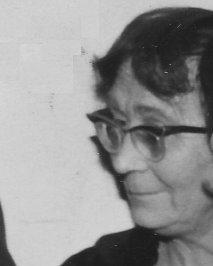
My next teacher was Miss Nellie Lewis. She was entirely different, although very musical, teaching piano lessons from home. She was very strict and certainly not even tempered. If anyone annoyed her they were either tapped on the head with her whistle or across the knuckles with a rule. Life in her class was an entirely different experience. However she took us on nature rambles in the summer which we all enjoyed and we had great fun walking as far as Bath Spout at Doseley and into Holywell Lane. She also taught us country dancing and we went to many local fetes to dance.
I remember she also took us on one occasion to dance for a group of what seemed to us to be very important people at Attingham Hall, when it was an adult education college. What impressed me most about the trip was that she played the grand piano in the large room where we were dancing. After Miss Lewis, the next class we went into was taught by Mr George Evans, now a well known local historian in Wellington. He used to recite the poem Jabberwocky to us which we all thought was hilarious. When we were in his class some of us were chosen to be coached for the eleven plus exam and so we went into the top class taught then by Mr Latham.
When I first started school, the headmaster was called Mr Crimes or Chrimes who I remember as being a very pleasant man, but he soon left after I started. Then I remember Mr Eric Latham. Mr Latham was strict but kind and also very musical. His wife was a well-known local piano and singing teacher.
They lived in Wellington in one of the large semi-detached houses in Watling Street. I don’t remember anyone being given the cane but if we were very noisy or disruptive he would get the cane out of the cupboard and threaten us with it. One thing Mr Latham was very keen on was that
Extracts from the book, Dawley Green By B. T. Duckett.
FIRST IMPRESSIONS, SCHOOL AND PLAY.
This Book is based upon the memories of a school boy living in Dawley during the 1930's. It hopes to give some idea of life in the years prior to the Second World War, when the writer was a pupil at the Dawley C of E or "National" School.
Although born in Horsehay I lived in the Black Country until 1935, when my family returned to Dawley. I recall how quiet and almost rural the area seemed when compared with our previous surroundings. The streets appeared to have only light traffic, much of it horse- drawn, and in the days before starting at my new school I used to look forward to seeing the little delivery vans and milk floats, and the drivers of these vehicles were among the first local people that I came to know.
Within a couple of weeks I had been accepted at the National School, this being the most convenient place only a few minutes walk from my home. The Head Teacher at the time was, Mr F. Clayton, of Horsehay, and among the other staff were, Mr C. Tranter of Doseley, and the Misses Barnett, Peake, and Price. Being an all-age school it took children from five to fourteen year's, and here I was to stay until shortly after my 14th birthday.
The school day began with a general assembly for prayer and a hymn, usually accompanied by the Head- master playing a small harmonium. When this little service was over we went to our desks and lessons would commence. The length of a school day was similar to that of the present time. Our desks had small china ink-wells and old fashioned wooden nib- pens and under the sloping lid was a space for books. Two pupils shared a desk in large classes which must have had over forty boys and girls.
Many children living up to a mile away would walk home for lunch and back within the hour and a quarter which was allowed. There was of course no school dinner service, but we could buy small bottles of milk, about a third of a pint, at morning break.
The main subjects on the curriculum were the basic essentials of reading, writing and arithmetic, plus geography, history, and religious instruction, but in between a story would be read to us. Most of these stories were from popular classics such as the works of Charles Dickens and Mark Twain and we heard plenty of "David Copperfield", "A Christmas Carol" and "Tom Sawyer", which were read to us in short episodes.
During the morning break, we were let out to play on the old pit mound behind the school which was alright in dry weather, but the clay was liable to "run" in heavy rain and wash down into the yard like thick milk, making a mess of our shoes if we stepped into it. The afternoon break was longer and for this we could go down to the "Council Field" by the park to play foot- ball or cricket, according to season. It was mostly unsupervised play with no coaching and only minimal equipment. Sports Masters and P.E. Instructors were not employed in Elementary Schools, and few families could afford to provide sports gear, so these activities were not developed to the standards existing today.
The Anglican Doctrine played a large part in the life of C of E schools, and in addition to morning prayer, a prayer was said at the close of each session, usually "Be present at our table Lord", before lunch, and "Lighten our darkness" at the end of the day. On certain occasions the Vicar of Dawley would take morning service and on Ash Wednesday we were marched down to the Parish Church for a special service after which we could go home for the rest of the day,
The better known bible stories were often read to us and periodically an examination in religious knowledge would be held. Children reaching the age of 13 were invited to apply for Confirmation and help was given to candidates preparing for this, but only a minority of parents were regular churchgoers and the number of applicants was very small.
When winter came the classrooms were not very warm, especially for those sitting a distance away from the large open fireplace at the front of the class. It was a case of wrapping up warm and it did not matter how we looked as there was no kind of uniform. Uniforms were only worn at Grammar Schools such as Wellington or Coalbrookdale High Schools, to which places a few of our brighter pupils went after passing the 11-Plus examination.
In due course, I sat for one of these exams, but like the majority of my fellows, application to study had been insufficient and failure ensued. I think only about 4 or 5 out of over 20 who sat with me were successful and did go to Grammar Schools, although it must have meant quite a sacrifice on the part of their parents who would then receive little in the way of financial help towards the extra expense involved.
Those selected for secondary education were looked upon as a kind of elite and most of us had no great sense of disappointment at not being among the "chosen". In fact I think we realised that we would not fit in at the more advanced seats of learning. I was however, old enough to understand that my failure to qualify might have an effect on my future working life.
School discipline was not over strict and canes were used sparingly even on some unruly characters who no doubt deserved more than they got. The school was by no means a "Blackboard-Jungle" although it was regarded by some as a "rough" school when compared with Lawley or Pool Hill which were then thought of as the best elementary establishments. I do not doubt that our teachers did their best in a rather deprived catchment area.
In the free time after school and at weekends, I discovered that there were vast expanses of waste land with numerous pit mounds on all sides of Dawley. These areas had become the main playgrounds for local children and we were fortunate in having so much space with un- limited access. All the usual games were played on this derelict land where some of the mounds had large flat tops, suitable for ball games. Sometimes "Cowboys and Indians", "Cops and Robbers", or some battle we had seen on the "pictures" would be enacted.
My main area in the early days was the old Roughground which has largely given way to the new estates of Chiltern Gardens, Purbeckdale, and Mountside. There were some dangerous old mine shafts, still open and often fenced with only a few strands of wire, into which we could drop stones and count the seconds till they reached the pit bottom. No doubt there would be an outcry if those shafts were still open, but I never heard of any accidents, and no-one seemed concerned about them.
The Brandlee and Paddock mounds also afforded plenty of play space, and another "place of interest" was the old council tip at the side of the Doseley Road. Here could be found all kinds of things, including bicycle wheels to make "Bowlers", and pram wheels to build onto wooden go-carts. Some ingenious boys would' keep visiting the tip to build up a stock of bike spares, and the end result of their efforts became a home-made bicycle which was often ridden round the side streets without brakes, tyres or saddle.
By B. T. Duckett